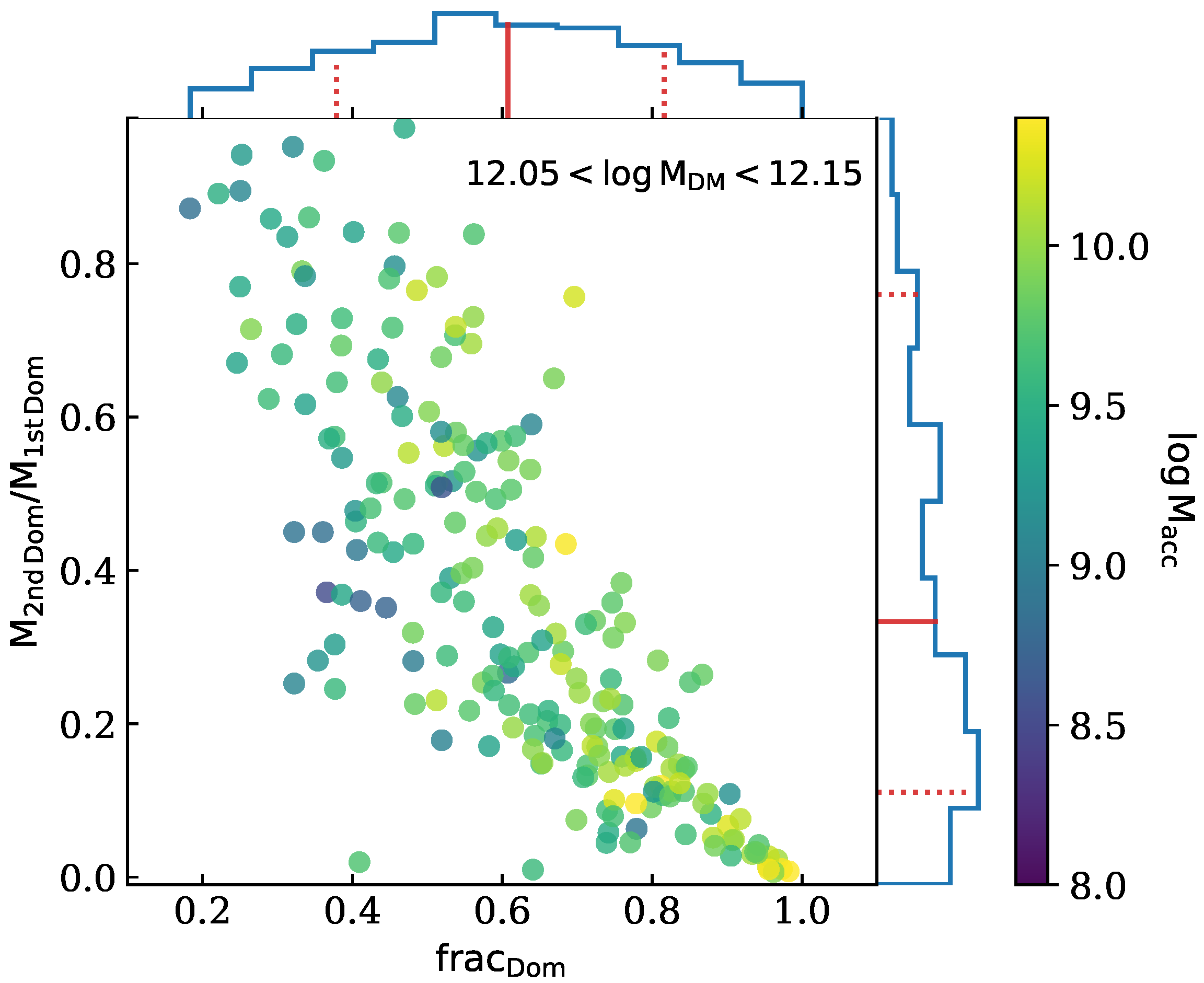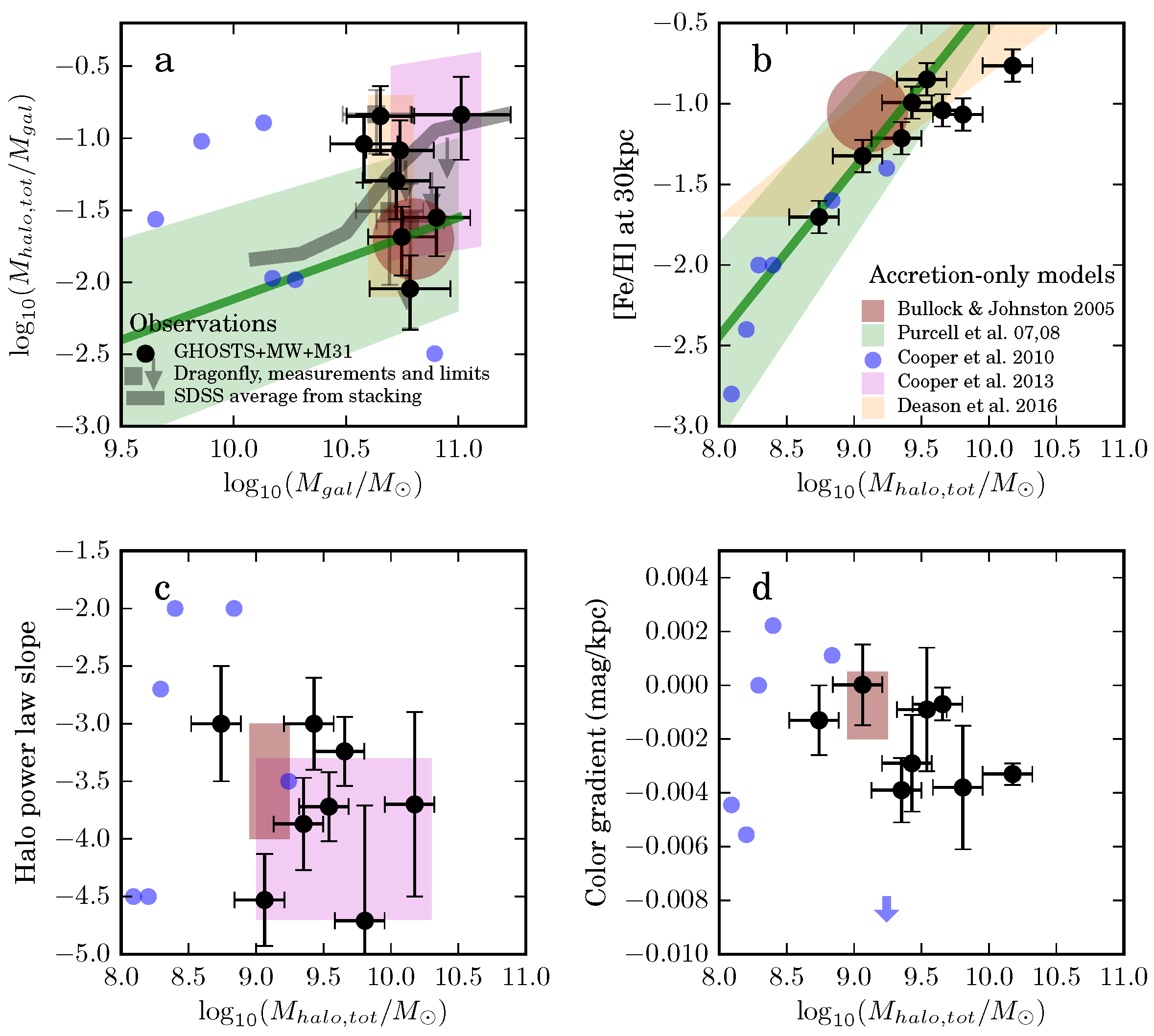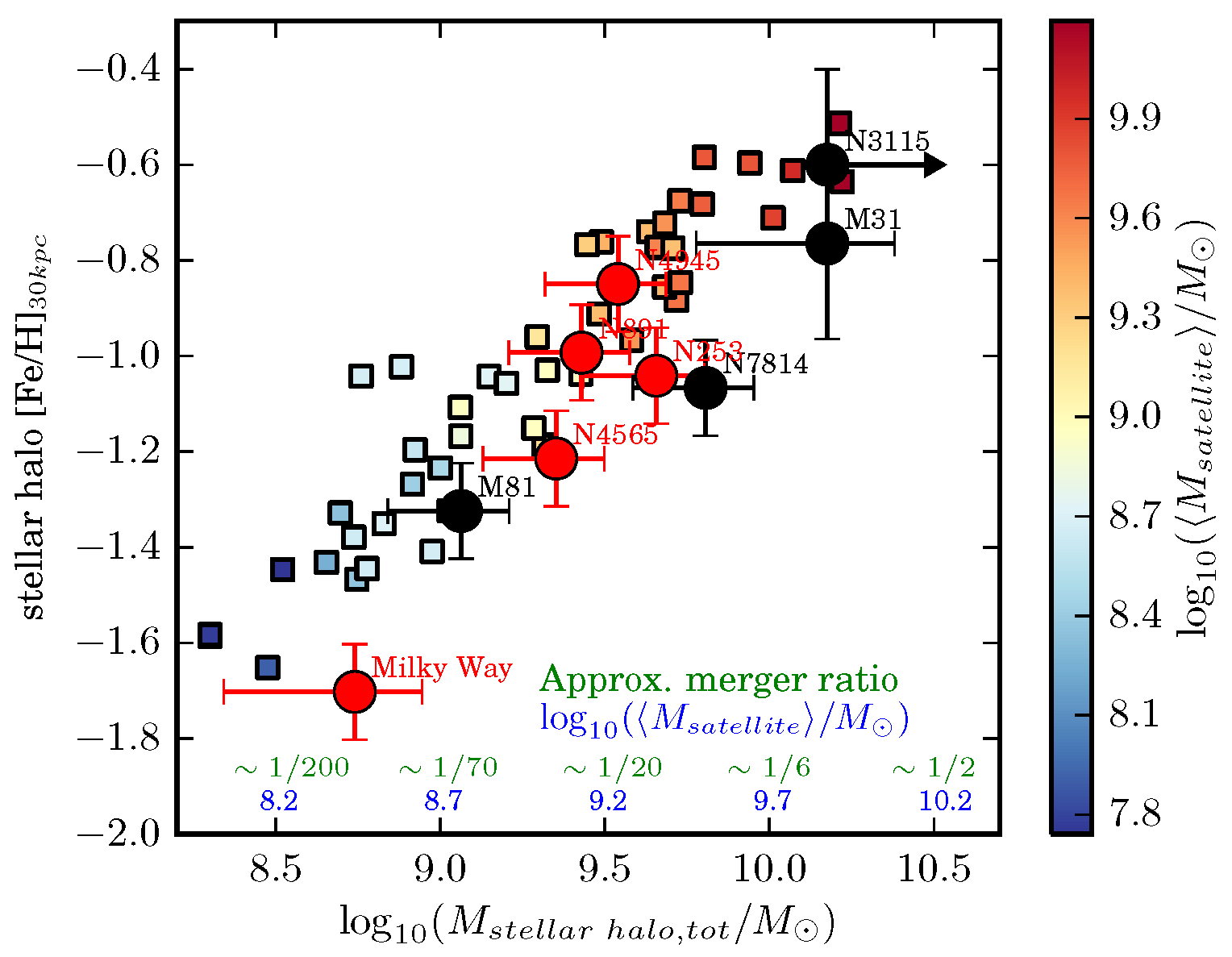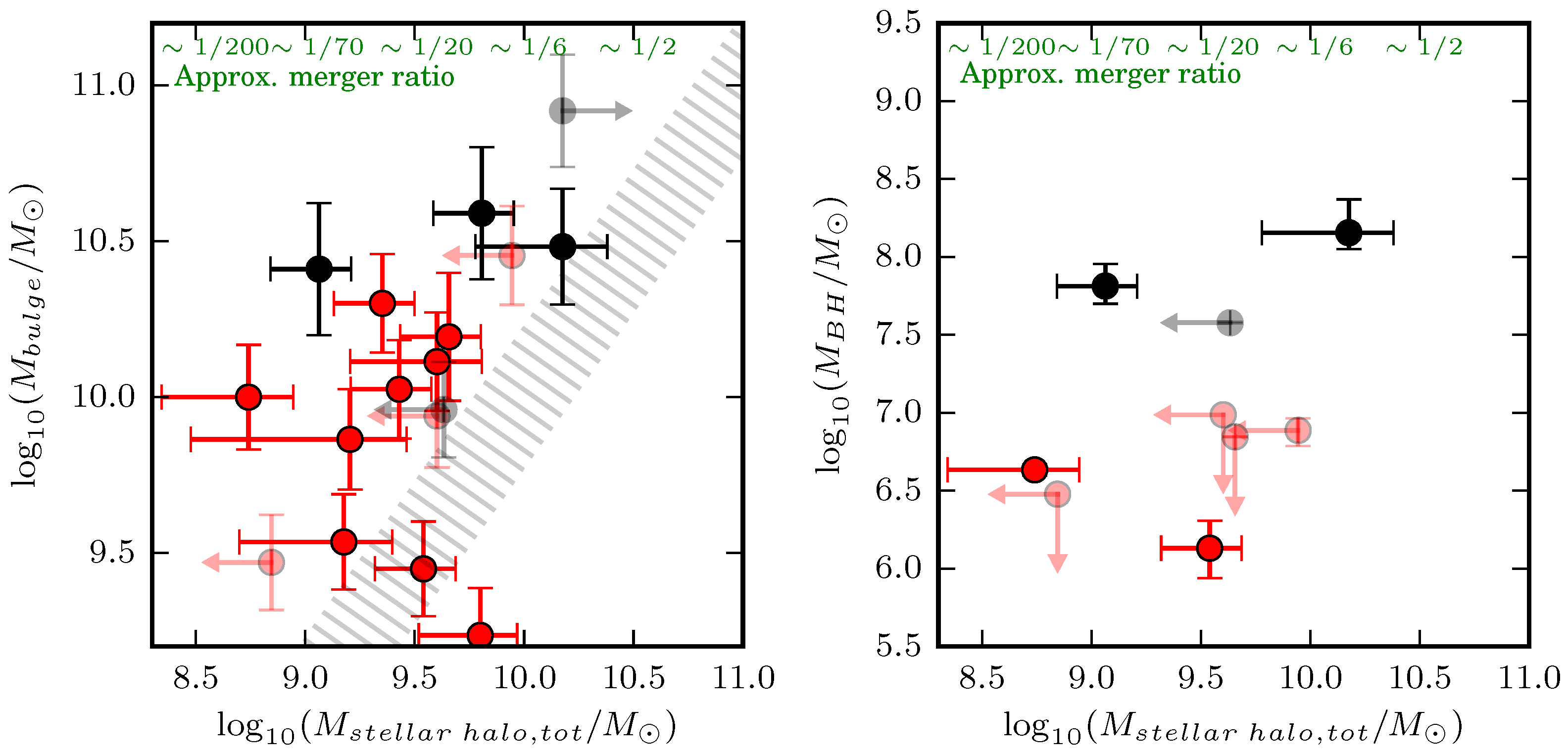Decoding Galactic Merger Histories
Abstract
1. Introduction
2. Stellar Halos Measure Merger History
3. MW Peer Stellar Halos Are Diverse, Reflecting a Diversity in Merger and Accretion Histories
- Following Section 2, it strongly suggests that the observations have indeed quantified the accreted stellar halo of galaxies.
- It shows that MW peers have a wide range of merger histories, where the Milky Way’s low-mass stellar halo is very unusual. This is important because it tells us that the intuition that we have built about stellar halos from study of the Milky Way is incomplete.
- These accreted stellar halos can be used as a tool to quantify the properties of the most massive merger to have affected galaxies. The astronomical community now has quantitative access to the most massive event in individual galaxy’s merger and accretion history.
4. Bulges and Central Black Holes in Disk-Dominated Galaxies Correlate Poorly with Merger History
5. Conclusions
Acknowledgments
Author Contributions
Conflicts of Interest
References
- Hopkins, P.F.; Bundy, K.; Croton, D.; Hernquist, L.; Keres, D.; Khochfar, S.; Stewart, K.; Wetzel, A.; Younger, J.D. Mergers and Bulge Formation in ΛCDM: Which Mergers Matter? Astrophys. J. 2010, arXiv:astro-ph.CO/0906.5357715, 202–229. [Google Scholar] [CrossRef]
- Somerville, R.S.; Davé, R. Physical Models of Galaxy Formation in a Cosmological Framework. Annu. Rev. Astron. Astrophys. 2015, arXiv:1412.271253, 51–113. [Google Scholar] [CrossRef]
- Bullock, J.S.; Kravtsov, A.V.; Weinberg, D.H. Hierarchical Galaxy Formation and Substructure in the Galaxy’s Stellar Halo. Astrophys. J. 2001, arXiv:astro-ph/0007295548, 33–46. [Google Scholar] [CrossRef]
- Bullock, J.S.; Johnston, K.V. Tracing Galaxy Formation with Stellar Halos. I. Methods. Astrophys. J. 2005, arXiv:astro-ph/0506467635, 931–949. [Google Scholar] [CrossRef]
- Purcell, C.W.; Bullock, J.S.; Zentner, A.R. Shredded Galaxies as the Source of Diffuse Intrahalo Light on Varying Scales. Astrophys. J. 2007, arXiv:astro-ph/0703004666, 20–33. [Google Scholar] [CrossRef]
- Cooper, A.P.; Cole, S.; Frenk, C.S.; White, S.D.M.; Helly, J.; Benson, A.J.; De Lucia, G.; Helmi, A.; Jenkins, A.; Navarro, J.F.; et al. Galactic stellar haloes in the CDM model. Mon. Not. R. Astron. Soc. 2010, arXiv:astro-ph.GA/0910.3211406, 744–766. [Google Scholar] [CrossRef]
- Monachesi, A.; Bell, E.F.; Radburn-Smith, D.J.; Bailin, J.; de Jong, R.S.; Holwerda, B.; Streich, D.; Silverstein, G. The GHOSTS survey - II. The diversity of halo colour and metallicity profiles of massive disc galaxies. Mon. Not. R. Astron. Soc. 2016, arXiv:1507.06657457, 1419–1446. [Google Scholar] [CrossRef]
- Harmsen, B.; Monachesi, A.; Bell, E.F.; de Jong, R.S.; Bailin, J.; Radburn-Smith, D.J.; Holwerda, B.W. Diverse stellar haloes in nearby Milky Way mass disc galaxies. Mon. Not. R. Astron. Soc. 2017, arXiv:1611.05448466, 1491–1512. [Google Scholar] [CrossRef]
- Bell, E.F.; Monachesi, A.; Harmsen, B.; de Jong, R.S.; Bailin, J.; Radburn-Smith, D.J.; D’Souza, R.; Holwerda, B.W. Galaxies Grow Their Bulges and Black Holes in Diverse Ways. Astrophys. J. 2017, arXiv:1702.06116837, L8. [Google Scholar] [CrossRef]
- D’Souza, R.; Bell, E. Accreted Metallicity-Stellar Mass Relationship. arXiv, 2017; arXiv:1705.08442. arXiv:1705.08442. [Google Scholar]
- Papovich, C.; Labbé, I.; Quadri, R.; Tilvi, V.; Behroozi, P.; Bell, E.F.; Glazebrook, K.; Spitler, L.; Straatman, C.M.S.; Tran, K.V.; et al. ZFOURGE/CANDELS: On the Evolution of M* Galaxy Progenitors from z = 3 to 0.5. Astrophys. J. 2015, arXiv:1412.3806803, 26. [Google Scholar] [CrossRef]
- Blanton, M.R.; Moustakas, J. Physical Properties and Environments of Nearby Galaxies. Annu. Rev. Astron. Astrophys. 2009, arXiv:0908.301747, 159–210. [Google Scholar] [CrossRef]
- Schweizer, F.; Seitzer, P. Correlations between UBV colors and fine structure in E and S0 galaxies—A first attempt at dating ancient merger events. Astron. J. 1992, 104, 1039–1067. [Google Scholar] [CrossRef]
- Rothberg, B.; Joseph, R.D. A Survey of Merger Remnants. II. The Emerging Kinematic and Photometric Correlations. Astron. J. 2006, arXiv:astro-ph/0510019131, 185–207. [Google Scholar] [CrossRef]
- Kormendy, J.; Kennicutt, R.C., Jr. Secular Evolution and the Formation of Pseudobulges in Disk Galaxies. Annu. Rev. Astron. Astrophys. 2004, arXiv:astro-ph/040734342, 603–683. [Google Scholar] [CrossRef]
- Johansson, P.H.; Naab, T.; Ostriker, J.P. Forming Early-type Galaxies in ΛCDM Simulations. I. Assembly Histories. Astrophys. J. 2012, arXiv:1202.3441754, 115. [Google Scholar] [CrossRef]
- Ceverino, D.; Dekel, A.; Tweed, D.; Primack, J. Early formation of massive, compact, spheroidal galaxies with classical profiles by violent disc instability or mergers. Mon. Not. R. Astron. Soc. 2015, arXiv:1409.2622447, 3291–3310. [Google Scholar] [CrossRef]
- Sales, L.V.; Navarro, J.F.; Theuns, T.; Schaye, J.; White, S.D.M.; Frenk, C.S.; Crain, R.A.; Dalla Vecchia, C. The origin of discs and spheroids in simulated galaxies. Mon. Not. R. Astron. Soc. 2012, arXiv:astro-ph.CO/1112.2220423, 1544–1555. [Google Scholar] [CrossRef]
- Terrazas, B.A.; Bell, E.F.; Henriques, B.M.B.; White, S.D.M.; Cattaneo, A.; Woo, J. Quiescence Correlates Strongly with Directly Measured Black Hole Mass in Central Galaxies. Astrophys. J. Lett. 2016, arXiv:1609.07141830, L12. [Google Scholar] [CrossRef]
- Terrazas, B.A.; Bell, E.F.; Woo, J.; Henriques, B.M.B. Supermassive Black Holes as the Regulators of Star Formation in Central Galaxies. Astrophys. J. 2017, 844, 170. [Google Scholar]
- Koss, M.; Mushotzky, R.; Veilleux, S.; Winter, L.M.; Baumgartner, W.; Tueller, J.; Gehrels, N.; Valencic, L. Host Galaxy Properties of the Swift Bat Ultra Hard X-Ray Selected Active Galactic Nucleus. Astrophys. J. 2011, arXiv:astro-ph.CO/1107.1237739, 57. [Google Scholar] [CrossRef]
- Ellison, S.L.; Patton, D.R.; Mendel, J.T.; Scudder, J.M. Galaxy pairs in the Sloan Digital Sky Survey - IV. Interactions trigger active galactic nuclei. Mon. Not. R. Astron. Soc. 2011, arXiv:1108.2711418, 2043–2053. [Google Scholar] [CrossRef]
- Deason, A.J.; Mao, Y.Y.; Wechsler, R.H. The Eating Habits of Milky Way-mass Halos: Destroyed Dwarf Satellites and the Metallicity Distribution of Accreted Stars. Astrophys. J. 2016, arXiv:1601.07905821, 5. [Google Scholar] [CrossRef]
- Vogelsberger, M.; Genel, S.; Springel, V.; Torrey, P.; Sijacki, D.; Xu, D.; Snyder, G.; Nelson, D.; Hernquist, L. Introducing the Illustris Project: simulating the coevolution of dark and visible matter in the Universe. Mon. Not. R. Astron. Soc. 2014, arXiv:1405.2921444, 1518–1547. [Google Scholar] [CrossRef]
- Purcell, C.W.; Bullock, J.S.; Zentner, A.R. The metallicity of diffuse intrahalo light. Mon. Not. R. Astron. Soc. 2008, arXiv:0805.2965391, 550–558. [Google Scholar] [CrossRef]
- Cooper, A.P.; D’Souza, R.; Kauffmann, G.; Wang, J.; Boylan-Kolchin, M.; Guo, Q.; Frenk, C.S.; White, S.D.M. Galactic accretion and the outer structure of galaxies in the CDM model. Mon. Not. R. Astron. Soc. 2013, arXiv:1303.6283434, 3348–3367. [Google Scholar] [CrossRef]
- Kirby, E.N.; Cohen, J.G.; Guhathakurta, P.; Cheng, L.; Bullock, J.S.; Gallazzi, A. The Universal Stellar Mass-Stellar Metallicity Relation for Dwarf Galaxies. Astrophys. J. 2013, 779, 102. [Google Scholar] [CrossRef]
- Zolotov, A.; Willman, B.; Brooks, A.M.; Governato, F.; Brook, C.B.; Hogg, D.W.; Quinn, T.; Stinson, G. The Dual Origin of Stellar Halos. Astrophys. J. 2009, arXiv:astro-ph.GA/0904.3333702, 1058–1067. [Google Scholar] [CrossRef]
- Cooper, A.P.; Parry, O.H.; Lowing, B.; Cole, S.; Frenk, C. Formation of in situ stellar haloes in Milky Way-mass galaxies. Mon. Not. R. Astron. Soc. 2015, arXiv:1501.04630454, 3185–3199. [Google Scholar] [CrossRef]
- Pillepich, A.; Vogelsberger, M.; Deason, A.; Rodriguez-Gomez, V.; Genel, S.; Nelson, D.; Torrey, P.; Sales, L.V.; Marinacci, F.; Springel, V.; et al. Halo mass and assembly history exposed in the faint outskirts: The stellar and dark matter haloes of Illustris galaxies. Mon. Not. R. Astron. Soc. 2014, arXiv:1406.1174444, 237–249. [Google Scholar] [CrossRef]
- Monachesi, A.; Gómez, F.A.; Grand, R.J.J.; Kauffmann, G.; Marinacci, F.; Pakmor, R.; Springel, V.; Frenk, C.S. On the stellar halo metallicity profile of Milky Way-like galaxies in the Auriga simulations. Mon. Not. R. Astron. Soc. 2016, arXiv:1512.03064459, L46–L50. [Google Scholar] [CrossRef]
- Malin, D.; Hadley, B. HI in Shell Galaxies and Other Merger Remnants. Publ. Astron. Soc. Aust. 1997, 14, 52–58. [Google Scholar] [CrossRef]
- Martínez-Delgado, D.; Gabany, R.J.; Crawford, K.; Zibetti, S.; Majewski, S.R.; Rix, H.W.; Fliri, J.; Carballo-Bello, J.A.; Bardalez-Gagliuffi, D.C.; Peñarrubia, J.; et al. Stellar Tidal Streams in Spiral Galaxies of the Local Volume: A Pilot Survey with Modest Aperture Telescopes. Astron. J. 2010, arXiv:1003.4860140, 962–967. [Google Scholar] [CrossRef]
- Duc, P.A.; Cuillandre, J.C.; Karabal, E.; Cappellari, M.; Alatalo, K.; Blitz, L.; Bournaud, F.; Bureau, M.; Crocker, A.F.; Davies, R.L.; et al. The ATLAS3D project - XXIX. The new look of early-type galaxies and surrounding fields disclosed by extremely deep optical images. Mon. Not. R. Astron. Soc. 2015, arXiv:1410.0981446, 120–143. [Google Scholar] [CrossRef]
- Trujillo, I.; Fliri, J. Beyond 31 mag arcsec−2: The Frontier of Low Surface Brightness Imaging with the Largest Optical Telescopes. Astrophys. J. 2016, arXiv:1510.04696823, 123. [Google Scholar] [CrossRef]
- Merritt, A.; van Dokkum, P.; Abraham, R.; Zhang, J. The Dragonfly nearby Galaxies Survey. I. Substantial Variation in the Diffuse Stellar Halos around Spiral Galaxies. Astrophys. J. 2016, arXiv:1606.08847830, 62. [Google Scholar] [CrossRef]
- Radburn-Smith, D.J.; de Jong, R.S.; Seth, A.C.; Bailin, J.; Bell, E.F.; Brown, T.M.; Bullock, J.S.; Courteau, S.; Dalcanton, J.J.; Ferguson, H.C.; et al. The GHOSTS Survey. I. Hubble Space Telescope Advanced Camera for Surveys Data. Astrophys. J. 2011, 195, 18. [Google Scholar] [CrossRef]
- Ibata, R.A.; Lewis, G.F.; McConnachie, A.W.; Martin, N.F.; Irwin, M.J.; Ferguson, A.M.N.; Babul, A.; Bernard, E.J.; Chapman, S.C.; Collins, M.; et al. The Large-scale Structure of the Halo of the Andromeda Galaxy. I. Global Stellar Density, Morphology and Metallicity Properties. Astrophys. J. 2014, arXiv:1311.5888780, 386–406. [Google Scholar] [CrossRef]
- Gilbert, K.M.; Kalirai, J.S.; Guhathakurta, P.; Beaton, R.L.; Geha, M.C.; Kirby, E.N.; Majewski, S.R.; Patterson, R.J.; Tollerud, E.J.; Bullock, J.S.; et al. Global Properties of M31’s Stellar Halo from the SPLASH Survey. II. Metallicity Profile. Astrophys. J. 2014, arXiv:1409.3843796, 76. [Google Scholar] [CrossRef]
- Rejkuba, M.; Harris, W.E.; Greggio, L.; Harris, G.L.H.; Jerjen, H.; Gonzalez, O.A. Tracing the Outer Halo in a Giant Elliptical to 25 R eff. Astrophys. J. Lett. 2014, arXiv:1406.4627791, L2. [Google Scholar] [CrossRef]
- Peacock, M.B.; Strader, J.; Romanowsky, A.J.; Brodie, J.P. Detection of a Distinct Metal-poor Stellar Halo in the Early-type Galaxy NGC 3115. Astrophys. J. 2015, arXiv:1412.2752800, 13. [Google Scholar] [CrossRef]
- Bell, E.F.; Zucker, D.B.; Belokurov, V.; Sharma, S.; Johnston, K.V.; Bullock, J.S.; Hogg, D.W.; Jahnke, K.; de Jong, J.T.A.; Beers, T.C.; et al. The Accretion Origin of the Milky Way’s Stellar Halo. Astrophys. J. 2008, arXiv:0706.0004680, 295–311. [Google Scholar] [CrossRef]
- Xue, X.X.; Rix, H.W.; Ma, Z.; Morrison, H.; Bovy, J.; Sesar, B.; Janesh, W. The Radial Profile and Flattening of the Milky Way’s Stellar Halo to 80 kpc from the SEGUE K-giant Survey. Astrophys. J. 2015, arXiv:1506.06144809, 144. [Google Scholar] [CrossRef]
- Sesar, B.; Jurić, M.; Ivezić, Ž. The Shape and Profile of the Milky Way Halo as Seen by the Canada-France-Hawaii Telescope Legacy Survey. Astrophys. J. 2011, arXiv:1011.4487731, 4. [Google Scholar] [CrossRef]
- D’Souza, R.; Kauffman, G.; Wang, J.; Vegetti, S. Parametrizing the stellar haloes of galaxies. Mon. Not. R. Astron. Soc. 2014, arXiv:1404.2123443, 1433–1450. [Google Scholar] [CrossRef]
- Rodriguez-Gomez, V.; Pillepich, A.; Sales, L.V.; Genel, S.; Vogelsberger, M.; Zhu, Q.; Wellons, S.; Nelson, D.; Torrey, P.; Springel, V.; et al. The stellar mass assembly of galaxies in the Illustris simulation: growth by mergers and the spatial distribution of accreted stars. Mon. Not. R. Astron. Soc. 2016, arXiv:1511.08804458, 2371–2390. [Google Scholar] [CrossRef]
- Grand, R.J.J.; Gómez, F.A.; Marinacci, F.; Pakmor, R.; Springel, V.; Campbell, D.J.R.; Frenk, C.S.; Jenkins, A.; White, S.D.M. The Auriga Project: the properties and formation mechanisms of disc galaxies across cosmic time. Mon. Not. R. Astron. Soc. 2017, arXiv:1610.01159467, 179–207. [Google Scholar] [CrossRef]
- Renda, A.; Gibson, B.K.; Mouhcine, M.; Ibata, R.A.; Kawata, D.; Flynn, C.; Brook, C.B. The stellar halo metallicity-luminosity relationship for spiral galaxies. Mon. Not. R. Astron. Soc. 2005, arXiv:astro-ph/0507281363, L16–L20. [Google Scholar] [CrossRef]
- Font, A.S.; Johnston, K.V.; Bullock, J.S.; Robertson, B.E. Phase-Space Distributions of Chemical Abundances in Milky Way-Type Galaxy Halos. Astrophys. J. 2006, arXiv:astro-ph/0512611646, 886–898. [Google Scholar] [CrossRef]
| 1 | While Cen A’s minor axis metallicity at 30 kpc suggests that it has a large stellar halo mass, no published estimate exists, and so it is not shown in Figure 4. |




© 2017 by the authors. Licensee MDPI, Basel, Switzerland. This article is an open access article distributed under the terms and conditions of the Creative Commons Attribution (CC BY) license (http://creativecommons.org/licenses/by/4.0/).
Share and Cite
Bell, E.F.; Monachesi, A.; D’Souza, R.; Harmsen, B.; De Jong, R.S.; Radburn-Smith, D.; Bailin, J.; Holwerda, B.W. Decoding Galactic Merger Histories. Galaxies 2017, 5, 95. https://doi.org/10.3390/galaxies5040095
Bell EF, Monachesi A, D’Souza R, Harmsen B, De Jong RS, Radburn-Smith D, Bailin J, Holwerda BW. Decoding Galactic Merger Histories. Galaxies. 2017; 5(4):95. https://doi.org/10.3390/galaxies5040095
Chicago/Turabian StyleBell, Eric F., Antonela Monachesi, Richard D’Souza, Benjamin Harmsen, Roelof S. De Jong, David Radburn-Smith, Jeremy Bailin, and Benne W. Holwerda. 2017. "Decoding Galactic Merger Histories" Galaxies 5, no. 4: 95. https://doi.org/10.3390/galaxies5040095
APA StyleBell, E. F., Monachesi, A., D’Souza, R., Harmsen, B., De Jong, R. S., Radburn-Smith, D., Bailin, J., & Holwerda, B. W. (2017). Decoding Galactic Merger Histories. Galaxies, 5(4), 95. https://doi.org/10.3390/galaxies5040095




